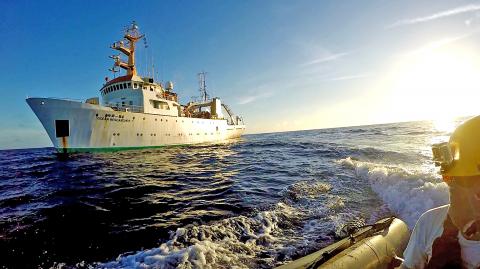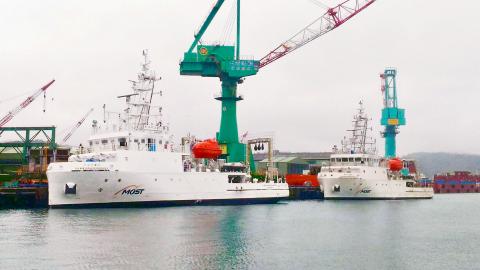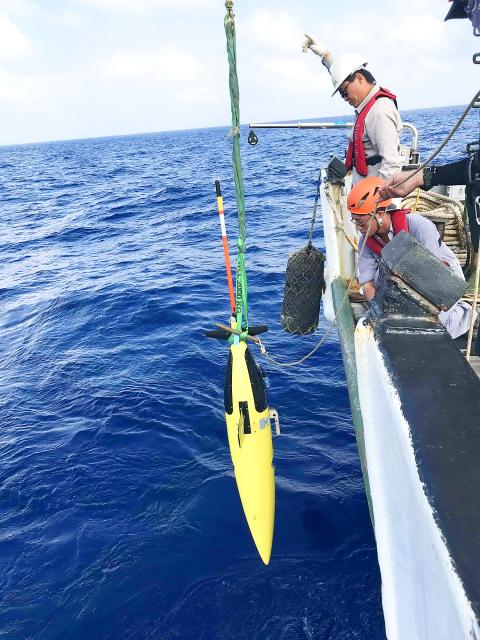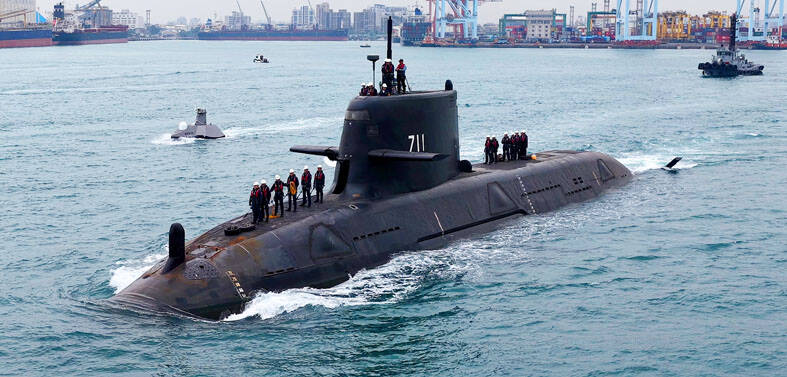Taiwanese oceanography is sailing into a new era with the establishment of more ocean-related agencies and research facilities, but the government’s inconsistent policies and ill-advised distribution of funds do not bode well for some veteran researchers.
The sinking of the 2,967-tonne Ocean Researcher V on Double Ten National Day in 2014, killing two researchers onboard, was a devastating blow to domestic oceanography.
“The loss is felt by the international community,” the journal Science reported two weeks after the shipwreck.

Photo courtesy of National Taiwan University Institute of Oceanography
It also drove a wedge between some academics and the Ministry of Science and Technology’s semi-official Taiwan Ocean Research Institute (TORI), whose decision to outsource vessel crew management proved unwise, said Wei Ching-ling (魏慶琳), a professor at National Taiwan University’s (NTU) Institute of Oceanography and former institute director.
More than four years later, a silver lining has appeared as the 2,629-tonne research vessel Legend (勵進), managed by the TORI, last month completed its first scientific expedition to collect geographical and atmospheric data in the South China Sea.
After the 2014 accident, the institute hired crewmembers itself to improve management, said TORI director Wang Chau-chang (王兆璋), who assumed the post in August 2017.

Photo courtesy of Oceanographic Society
Three new research vessels — the 2,200-tonne New Ocean Researcher I, 800-tonne New Ocean Researcher II and 800-tonne New Ocean Researcher III built by CSBC Corp — are to be delivered by the end of this year, Minister of Science and Technology Chen Liang-gee (陳良基) said.
Instead of having a government agency manage the vessels as some people have proposed, the ministry plans to have NTU, National Taiwan Ocean University and National Sun Yat-sen University (NSYSU) do so, Chen said.
The new vessels are designed to replace the 794-tonne Ocean Researcher I, 294-tonne Ocean Researcher II and 295-tonne Ocean Researcher III, which are managed by the three universities respectively.

Photo courtesy of National Taiwan University Institute of Oceanography
Academics had reasoned with the ministry before it reached a decision, Wei said.
Having managed the Ocean Researcher I for more than three decades, the Institute of Oceanography laid the critical foundation for management of the vessel and its precision instruments.
It has also been commissioned by the ministry to operate its Ocean Data Bank.

Photo: Lin Chia-nan, Taipei Times
However, the successive establishments of the TORI, the Ocean Affairs Council and the National Academy of Marine Research have made consistent planning of overall marine policy difficult, Wei said.
Inaugurated last month, the academy vowed to oversee national marine policy, manage a national ocean database, build a fleet of research vessels and foster the development of power generation from marine currents, among other goals.
In short, it is to take over certain responsibilities from the academia and the ministry.
The ocean-related agencies were often directed by engineers whose policies were seldom grounded in scientific evidence due to their lack of knowledge about oceans, Wei said.
His previous proposal that TORI use their ocean data buoys to monitor maritime and typhoon conditions in waters off Taiwan’s east coast did not meet a positive response, so he sought funds from various sources to support such a plan, which was first conceived by late institute professor Tang Tswen-yung (唐存勇), Wei said.
Their hard work paid off as their research paper on Super Typhoon Nepartak in 2016 using data collected from the buoys was published in the journal Nature Communications on April 9 and covered by numerous foreign media outlets.
Wei also questioned the council’s plan to promote marine current power development, saying it is “impossible” to control ocean currents.
Considered an expert in the field, NSYSU ocean engineer Chen Yang-yi (陳陽益) was appointed as the council’s first deputy minister in April last year.
His team in 2016 claimed to have installed the world’s first deep-sea pilot turbine with a capacity of 50 kilowatts (KW) in waters southeast of Pingtung County and generated 26.31KW of power when the Kuroshio current flowed at 1.27m per second.
Members of TORI, National Cheng Kung University (NCKU), Ching Fu Shipbuilding Co and Wanchi Steel Industrial Co were also part of the team, local media reported.
However, sources familiar with the matter said that their buoyant platform carrying the turbine was unmoored and washed out to the east coast.
Ching Fu in 2017 got embroiled in a fraud scandal involving naval minesweepers.
Nonetheless, the council last month approved another eight-month project for developing marine current power with a budget of nearly NT$65 million (US$2.06 million), just before Chen Yang-yi left his council post and returned to NSYSU this month.
The project was hosted by NSYSU marine engineer Shyue Shiahn-wern (薛憲文) and included other engineers from NTU and NCKU, the members of TORI, Wanchi Steel and Chung-hua Institution for Economic Research, but did not involve Ching Fu this time.
Chen Yang-yi said his name is not officially listed in the project, so he would not be handling the funds.
He confirmed that the turbine platform had floated away after consecutive typhoons, but said it was recovered and shipped back to NSYSU.
As the platform’s underwater mooring base is intact, they would develop stronger platforms and underwater foundations to resist typhoons, he said.
Team members are now testing a new turbine with a capacity of 400KW in waters off Tainan’s Anping Port (安平港) and plan to test it in deeper waters off the east coast where the Kuroshio passes, possibly in October, he said.
Next year, they would also work with Japanese firms to test turbines in deeper waters, and the council has budgeted up to NT$70 million for the plan, he said.
Unlike intermittent wind energy, the Kuroshio can be harnessed to generate power “any time,” he said, anticipating increasing exploitation of the current.
Chen Yang-yi’s role is not illegal, as he only serves as the team’s technical adviser, said Huang Shih-wei (黃世偉), director of the council’s Department of Technology and Cultural Affairs.
Institute of Oceanography director Jan Sen (詹森), who is also chairman of the Oceanographic Society, said that generating power from the Kuroshio is like “a pie in the sky” given current technological limitations.
A research paper led by Jan, titled “Large variability of the Kuroshio at 23.75°N east of Taiwan,” has quantified the “tremendous variability” of the current’s velocity, volume, flow structure, heat and salt transport using data collected from nine ship-based surveys from 2012 to 2014.
The paper, published in the Journal of Geophysical Research: Oceans in 2015, was identified by the American Geophysical Union as one of its “research spotlights.”
He and fellow researchers came to realize that the Kuroshio is not as stable as previously perceived, Jan said, lamenting that some people keep throwing government funds into the sea.
Apart from ongoing surveys east of Taiwan, they are also working on a collaborative project with the US Naval Research Laboratory and other institutions to study internal waves east of Dongsha Atoll in the South China Sea, Jan said.
He pursued the collaboration after the ministry shelved his integrated proposal for a project in the South China Sea involving physical oceanography, geological survey, disaster prevention, ocean acidification and biodiversity studies, although it was the government that encouraged him to make the proposal in early 2016, Jan said.
The suspension was allegedly due to national security concerns about their plan to install radars on Itu Aba (Taiping Island, 太平島), but the real cause has never been clear, he said.
“Despite limited funds, we are confident the [Taiwan-US] project would succeed and allow us to produce more excellent research papers to advance our knowledge of the complex marine system,” Jan said.
Asked about his expectations for the future of domestic oceanography, Jan said he hopes that young researchers would work harder to produce exceptional research and sustain the institute’s established connections with the global oceanographic community.
The government should also fully support oceanographic research to improve disaster mitigation, national defense and understanding about global warming, he added.
The science ministry said it is working on Earth sciences development with a more macroscopic perspective.
It has launched programs to improve natural disaster monitoring, exported related technologies to Southeast Asian countries last year and signed 10 memorandums of understanding with countries targeted by the New Southbound Policy, a ministry official said, adding that oceanographic surveys are no less important.

US climber Alex Honnold is to attempt to scale Taipei 101 without a rope and harness in a live Netflix special on Jan. 24, the streaming platform announced on Wednesday. Accounting for the time difference, the two-hour broadcast of Honnold’s climb, called Skyscraper Live, is to air on Jan. 23 in the US, Netflix said in a statement. Honnold, 40, was the first person ever to free solo climb the 900m El Capitan rock formation in Yosemite National Park — a feat that was recorded and later made into the 2018 documentary film Free Solo. Netflix previewed Skyscraper Live in October, after videos

NUMBERS IMBALANCE: More than 4 million Taiwanese have visited China this year, while only about half a million Chinese have visited here Beijing has yet to respond to Taiwan’s requests for negotiation over matters related to the recovery of cross-strait tourism, the Tourism Administration said yesterday. Taiwan’s tourism authority issued the statement after Chinese-language daily the China Times reported yesterday that the government’s policy of banning group tours to China does not stop Taiwanese from visiting the country. As of October, more than 4.2 million had traveled to China this year, exceeding last year. Beijing estimated the number of Taiwanese tourists in China could reach 4.5 million this year. By contrast, only 500,000 Chinese tourists are expected in Taiwan, the report said. The report

Temperatures are forecast to drop steadily as a continental cold air mass moves across Taiwan, with some areas also likely to see heavy rainfall, the Central Weather Administration (CWA) said. From today through early tomorrow, a cold air mass would keep temperatures low across central and northern Taiwan, and the eastern half of Taiwan proper, with isolated brief showers forecast along Keelung’s north coast, Taipei and New Taipei City’s mountainous areas and eastern Taiwan, it said. Lows of 11°C to 15°C are forecast in central and northern Taiwan, Yilan County, and the outlying Kinmen and Lienchiang (Matsu) counties, and 14°C to 17°C

STEERING FAILURE: The first boat of its class is experiencing teething issues as it readies for acceptance by the navy, according to a recent story about rudder failure The Hai Kun (海鯤), the nation’s first locally built submarine, allegedly suffered a total failure of stern hydraulic systems during the second round of sea acceptance trials on June 26, and sailors were forced to manually operate the X-rudder to turn the submarine and return to port, news Web site Mirror Daily reported yesterday. The report said that tugboats following the Hai Kun assisted the submarine in avoiding collisions with other ships due to the X-rudder malfunctioning. At the time of the report, the submarine had completed its trials and was scheduled to begin diving and surfacing tests in shallow areas. The X-rudder,